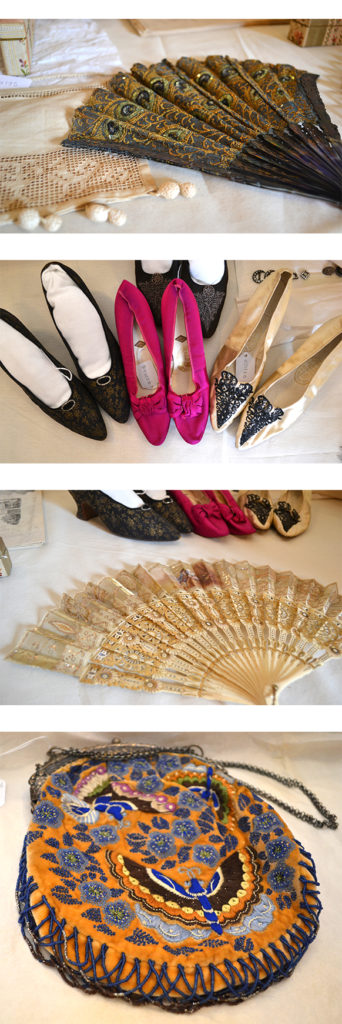Museum exhibits, suggests Secretary of the Smithsonian Lonnie Bunch, have the capacity to make the familiar unexpected, and the unfamiliar understood. And, even an exhibit on that most Newport of subjects – Vanderbilt fashion – can provide an opportunity to encourage the visitor to see things in a new light. Secretary Bunch cites the First Ladies exhibition at the Smithsonian to point out that:
“Too often in the past, the Smithsonian had documented and celebrated women by what they wore, rather than by what they accomplished. The redesign aimed to reconsider the exhibition’s most popular objects—the first ladies’ dresses—to tell a more thoughtful and comprehensive story. How Eleanor Roosevelt championed social justice and fairness, how Jackie Kennedy transformed public opinion of the White House.”
 In preparing for the upcoming exhibit, The World in Motion, Fashion and Modernity 1885-1945, curator Rebecca Kelly was presented with a previously unexamined collection of clothing and accessories belonging to three Vanderbilt women of New York and Newport. It would be easy, expected, and even lovely, to have simply focused on the glamor and beauty of the clothing, and the glossy lifestyles of the three women: Alice Gwynne Vanderbilt and her daughters Gertrude Vanderbilt Whitney and Gladys Moore Vanderbilt Széchényi.
In preparing for the upcoming exhibit, The World in Motion, Fashion and Modernity 1885-1945, curator Rebecca Kelly was presented with a previously unexamined collection of clothing and accessories belonging to three Vanderbilt women of New York and Newport. It would be easy, expected, and even lovely, to have simply focused on the glamor and beauty of the clothing, and the glossy lifestyles of the three women: Alice Gwynne Vanderbilt and her daughters Gertrude Vanderbilt Whitney and Gladys Moore Vanderbilt Széchényi.
But here, as at the Smithsonian, Ms. Kelly has chosen to pull some less obvious threads. Sure, by all means, come for the dazzling fashion; it will be on display. As will a discussion of haute couture. But so too will be some less obvious, less expected stories. One such thread involves the role that World War I played in the dynamic of American consumerism and design. As women took a role in the war effort and were cut off from what had been traditional shopping trips to Europe, American retailers and designers came to the forefront. A bit more obviously, as American women moved more into the shared center of national social life in the early 20th century – working, sporting, and driving for travel and for pleasure, fashion was required to make an adjustment. And Newport was a center for this.
The exhibit also focuses on the interlocking trades, and avenues for creativity — both here and abroad — that supplied American women with the opportunity to be fashionable. Designers, dressers, fabric and lace makers and entrepreneurs contributed to what was, and in many ways still is, an elaborate economic web. Women played a role here, at all walks of life, both as producers and consumers.
It is undoubtably the case that the more “thoughtful and comprehensive” approach to talking to the public about history is at the core of NHS’s practice in 2021. We seek always to present historical facts, moments, and objects in context, and to avoid oversimplifying. Surveys of our audiences have told us that you expect this from us – not to be told what to think, but certainly to be provided with a broad perspective. We, and most American museums are struggling to do this while talking about the most fraught and complicated moments in our history. Here too, in something as simple as a fashion and design exhibit, we can still strive to be more inclusive and less expected in our approach.
Please visit The World in Motion, Fashion and Modernity 1885-1945 in the Alletta Morris Gallery and the Leatherman Program Space at NHS’s Resource Center at 82 Touro Street and in the galleries at our partner institution, the Audrain Auto Museum, 220-230 Bellevue Avenue, starting at the end of May. Watch our website for more information.
The exhibit was made possible by support from:
![]()
The Alletta Morris McBean Charitable Trust
The Honorable Juliette C. McLennan
Banner: Ewer, Raymond Crawford, Artist. A sketch-book at Newport / Raymond Crawford Ewer Newport ’04 R.I. ; drawn by Raymond C. Ewer. Newport Rhode Island, 1914. New York: Published by Puck Publishing Corporation, 295-309 Lafayette Street. Photograph. https://www.loc.gov/item/2011649811/.